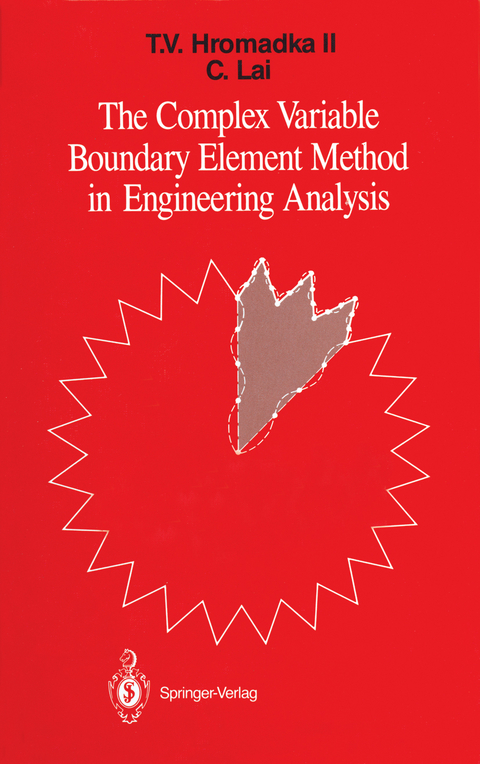
The Complex Variable Boundary Element Method in Engineering Analysis
Springer-Verlag New York Inc.
978-1-4612-9103-9 (ISBN)
1 Basic Principles and Mathematical Models of Engineering Mechanics Problems.- 1.0 Introduction.- 1.1 Ideal-Fluid Flow.- 1.2 Porous Media Flow.- 1.3 Fickian Diffusion.- 1.4 Heat Flow.- 1.5 Elasticity Problems.- 1.6 Use of Laplace Equation.- 1.7 Mathematical Modeling.- 1.8 Computational Mechanics and Hydraulics.- 1.9 Modeling of Potential Problems.- 2 A Review of Complex Variable Theory.- 2.0 Introduction.- 2.1 Preliminary Definitions.- 2.2 Polar Forms of Complex Numbers.- 2.3 Limits and Continuity.- 2.4 Derivatives: Analytic Functions.- 2.5 The Cauchy-Riemann Equations and Harmonic Functions.- 2.6 Complex Line Integration.- 2.7 Cauchy’s Integral Theorem.- 2.8 The Cauchy Integral Formula.- 2.9 Taylor Series.- 2.10 Program I: A Complex Polynomial Approximation Method.- 2.11 Complex Variables and Two-Dimensional Fluid Flow.- 3 Mathematical Development of The Complex Variable Boundary Element Method (CVBEM).- 3.0 Introduction.- 3.1 Basic Definitions.- 3.2 Characteristics of the Linear Global Trial Function.- 3.3 The H1 Approximation Function.- 3.4 Higher Order HK Approximation Functions.- 3.5 Using ? or ? Functions as Boundary Conditions.- 4 A Computer Algorithm for the Complex Variable Boundary Element Method.- 4.0 Introduction.- 4.1 A Complex Variable Boundary Element Approximation Model.- 4.2 The Analytic Function Defined by the Approximation $$/hat w/left( z /right)$$.- 4.3 Program 2: A Linear Basis Function Approximation $$/hat w/left( z /right)$$.- 4.4 A Constant Boundary Element Method.- 4.5 Summary of Basic CVBEM Modeling Algorithm.- 5 Reducing CVBEM Approximation Error.- 5.0 Introduction.- 5.1 Application of the CVBEM to the Unit Circle.- 5.2 Approximation Error from the CVBEM.- 5.3 A CVBEM Modeling Strategy to Reduce Approximation Error.- 5.4 A Modified CVBEMNumerical Model.- 5.5 Program 3: A Modified CVBEM Numerical Model.- 5.6 Determining Some Useful Error Bounds for the CVBEM.- 6 The Approximative Boundary.- 6.0 Introduction.- 6.1 Expansion of the HK Approximation Function.- 6.2 Upper Half Plane Boundary Value Problems.- 6.3 The Approximative Boundary for Error Analysis.- 6.4 Program 4: Analytic Continuation Model.- 6.5 Locating Additional Nodal Points on ?.- 7 CVBEM Modeling Techniques.- 7.0 Introduction.- 7.1 Sources and Sinks.- 7.2 Program 5: Source and Sink Model.- 7.3 Regional Inhomogeneity.- 7.4 Program 6: Nonhomogeneous Domain.- 7.5 The Poisson Equation.- 7.6 Computer-Aided-Analysis and the CVBEM.- 8 CVBEM Applications.- 8.0 Introduction.- 8.1 Modeling Nonuniform St. Venant Torsion.- 8.2 Numerical Calibration of Domain Models.- 8.3 Modeling Steady State, Advective Contaminant Transport.- 8.4 A Simple Model of Soil Water Phase Change.- 8.5 Modeling Two-Dimensional Steady State Soil Freezing Fronts.- References.- List of Symbols.- Mathematical Notations.
| Zusatzinfo | VIII, 389 p. |
|---|---|
| Verlagsort | New York, NY |
| Sprache | englisch |
| Maße | 155 x 235 mm |
| Themenwelt | Mathematik / Informatik ► Mathematik ► Algebra |
| Mathematik / Informatik ► Mathematik ► Angewandte Mathematik | |
| Medizin / Pharmazie ► Medizinische Fachgebiete ► Pharmakologie / Pharmakotherapie | |
| Medizin / Pharmazie ► Pharmazie | |
| Naturwissenschaften ► Physik / Astronomie ► Mechanik | |
| Technik | |
| ISBN-10 | 1-4612-9103-8 / 1461291038 |
| ISBN-13 | 978-1-4612-9103-9 / 9781461291039 |
| Zustand | Neuware |
| Haben Sie eine Frage zum Produkt? |
aus dem Bereich


